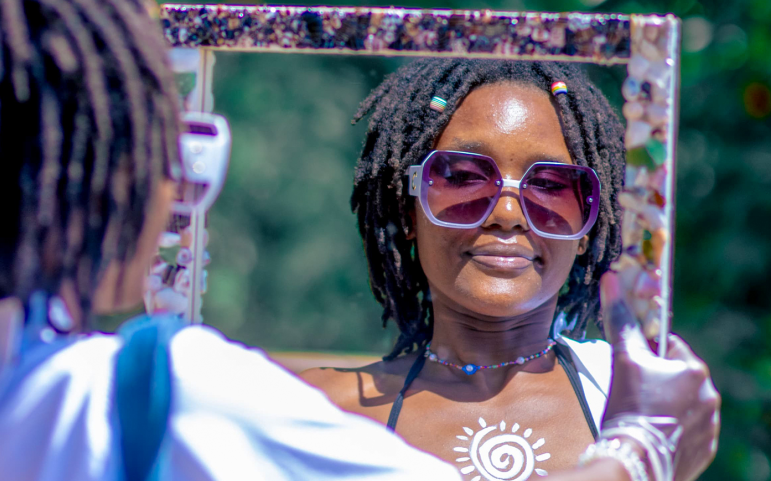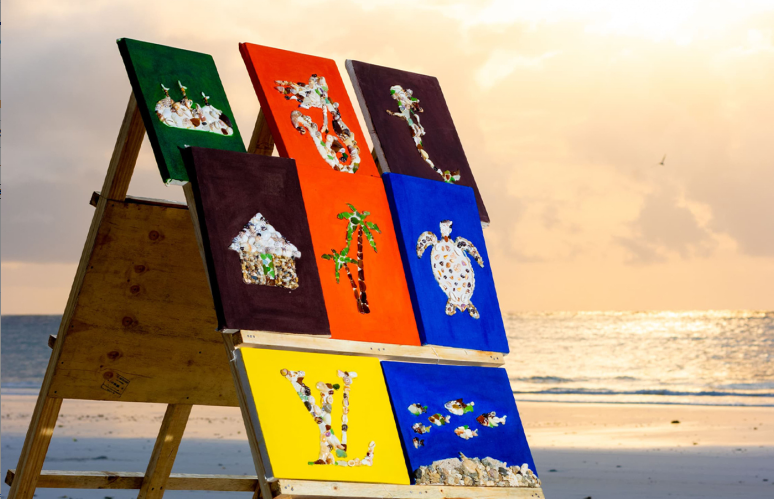

From hidden treasures beneath the sands of Kenya’s coastline to sustainable art, seashells have become the prized centrepiece of a community initiative that supports local artists, promotes marine conservation and creates economic opportunities in a region where youth unemployment remains a persistent issue.
Story by Velma Pamela, bird story agency
In a modest studio in Bofa, Kenya’s Kilifi County, workers clean and sort seashells. Unfinished mirror frames sat on one table, while strands of shell earrings adorned another.
There was no expensive machinery—only glue guns, sketchy sketches, and time. Pieces came together gradually, sometimes over the course of a few days. The work was systematic and labor-intensive. It may not have looked like much, but it has created jobs in unexpected ways.
Kenya's coastline spans the Indian Ocean, connecting historic settlements: Lamu, Mombasa, and Kilifi. For centuries, the region was part of the Indian Ocean trade routes that connected East Africa to the Middle East and Asia.
Coastal communities once used shells widely—for jewellery, in rituals, and even as a form of currency in some regions. They were used in household products and traditional crafts.
However, their practical and cultural relevance decreased over time. Many of the practices that gave shells meaning have vanished, and they are now commonly viewed as debris on the shore. Omari Saban, 24, and Martin Luganje, 26, co-founded Buddies Box Kenya in 2023 to restore the value of seashells.
The sustainable enterprise combines creativity and environmental responsibility. For Omari Soban, who was born in Mombasa, the journey did not begin with a business plan but with quiet frustration.
After graduating from high school in 2019, he spent three difficult years working as a boda boda rider, often returning home with nothing. By early 2023, he was tired of the cycle and looking for something more stable. “It reached a point where I wanted to do something else.”
According to a 2024 reference from the African Development Bank, despite being one of Africa's fastest-growing sectors, just 3.1% of young people are working in the creative economy.
In Kenya, youth between the ages of 18 and 34 make up over 80% of the country’s unemployed population. During his regular beach walks, he saw the large number of shells scattered over the shore, discarded and ignored.
Around this period, Soban reconnected with Martin Luganje, his longtime friend. Martin, who had recently graduated from university, had returned home but had yet to find employment. They shared an interest in art, but more importantly, they were frustrated that so much potential in Kilifi was going untapped.
“If you ask most of the local people in Kilifi or around the coastal places, they'll just tell you shells are something they treat more like litter. It's not something they value as much.” Luganje said.
Initially, they experimented with coconut shells but quickly moved on. “Processing the coconut shells was very difficult because we had to have some bigger machines. It’s not easy to work on them,” Omari says.
They eventually started collecting shells in their spare time, frequently traveling the length of the popular Bofa Beach, with bags in hand. They cleaned and organized them, experimenting with how different forms and textures would go together. “One thing people don't notice is when you look at a shell, you can tell a story from it,” Luganje said.
“For example, when you have two clamshells and you put them together…you can see a btterfly from the shell.” Their first DIY piece was a simple mirror. “We bought glue guns, glue sticks, and local rocks,” said Soban. “It cost us about 1,500 Kenyan shillings.”

That mirror marked the beginning of a broader vision: to transform discarded beach shells into sustainable, wearable, and decorative art.
They began manufacturing earrings, keychains, tote bags, and wall hangings. They named the business Buddies Box — _buddies _for their friendship and _box_ for the concept of collecting and arranging components. Together, they created shell earrings costing between 100 and 200 shillings, hand-decorated tote bags, and larger canvas artworks that might sell for up to 5,000 shillings depending on complexity.
Registering Buddies Box Kenya in May 2024 was a significant milestone, which was funded entirely by their limited savings.
“It cost us 2,000 shillings to register,” Soban said. “But it made us feel legit. Like we were finally building something real.”
At first, they sold primarily to friends and neighbors. A few tiny shops placed orders. Hotel owners sought customized decor. Word spread gradually.
Martin and Omari's story is becoming increasingly frequent as young people resort to innovation and resourcefulness to carve out their livelihoods. They are often excluded from regular employment; therefore, they are creating alternatives, redefining what work looks like, and where value can be found.
“We realized it wasn’t just about us,” Luganje said. “There were so many other young people around doing nothing, just waiting. Some of them had skills—drawing, crafting, but nowhere to apply them.” So they started involving others.
By mid-2024, the crew had grown to include four more members and started to operate more like a business. As orders grew, they partnered with local carpenters, motorbike taxis, and tailors.
By the end of 2024, Buddies Box had worked with at least 15 young people on a part-time or project basis, some supported production and photography, while others learned to price, package, and present their work at local markets.
Yusto Mwakesi, a Kilifi-based photographer and cameraman, watched their evolution firsthand.
“I started working with Buddies Box in August 2024, when they brought their first mirror artwork to my studio,” he says. “I was impressed by what they had done. Since then, we’ve worked together on several shoots, and I even incorporated some of their pieces, like their mirrors and wall art into my projects. What they’re doing is powerful. They’ve found a way to use local, available materials to create both income and environmental awareness.”
Their influence stretched beyond art. Buddies Box participated in a Tuza Awards beach cleaning in November 2024 at Baobab Beach, another well-known Kilifi beach. The Tuza Awards, which acknowledges young changemakers improving ocean conservation across Africa, worked with local organizations to showcase community-led environmental initiatives.
As a result, they organized their cleaning on April 7, 2025, at Mazingira Park.
“We hosted different local organizations and NGOs...and collected over 20kg of waste and shells,” Saban said.
Buddies Box's cleanups are not imported solutions; they are rooted in their relationship with the environment. This type of initiative exemplifies Afrocentric environmentalism: it is low-cost, community-driven, and directly linked to cultural identity.
Cathy Msafari, founder of Mawono Blossom and an advocate for sustainable art, believes that sustainable art efforts reflect a major shift in how communities approach creativity.
Environmental advocacy in Africa is frequently informed by personal experience. For populations around coastlines, forests, and deserts, the consequences of environmental deterioration are direct and personal.
“There is long-term value, not just in the product, but in the process.”
She adds that what stands out about such sustainable initiatives is how their work blends environmental awareness with local impact. “They’re not just making art, they’re creating opportunities for youth and investing back into their community. She concluded.”
That same year, 2025, they received the Tuza Marine Champion Award, a recognition of their environmental advocacy. “It was the first time we combined the cleanup with our art collection,” Luganje said. “We want people to see the connection between waste, the environment, and what we make.”
The award brought visibility, but also pressure to keep going.
This approach, rooted in local beginnings, peer collaboration, and community reinvestment, has become a compelling model for youth-led movements across Africa. In places where formal support systems are thin, peer collaboration and informal economies often carry the weight.
But the road hasn’t been easy. “One of the biggest challenges is time,” said Luganje. “Another is people putting little value in the sustainable arts. Some people think we just go to the beach, pick things up, and just put them there.” He explains that behind every piece is a slow, deliberate process, collecting, cleaning, sorting, designing, and assembling. Still, the use of natural, locally sourced materials often leads some customers to underestimate the effort and value behind the work.
Soban also highlights the logistical obstacles: “Sales and transportation have been a challenge,” he says. Getting their products to markets or exhibitions outside Kilifi is often expensive, and local demand can be inconsistent. Without reliable transport or digital infrastructure, reaching wider audiences has remained a hurdle.
Despite this, they see the value in continuing. For Soban, it means reliable income after years of instability. For Luganje, it’s about building something from his home region. “People often leave Kilifi to find work,” he says. “We’re trying to show that it’s possible to stay and still do something meaningful.” Buddies Box may be based in Kilifi, but its vision resonates across the African continent, where young people with limited resources but abundant creativity are building meaningful ventures from the ground up.
Their current goal is to build a permanent space in Kilifi where their art can be shown and others can learn the skills. They hope to train more young people. "There are many with talent but no place to apply it," according to Omari.
Their work reflects a broader shift in the jobs market in which sustainability meets innovation, art becomes a weapon for both expression and economic change, and communities are no longer waiting for solutions but rather making them. Buddies Box is creating a particularly African, deeply entrenched, and boldly forward-looking future by recycling shells into valuable products.















